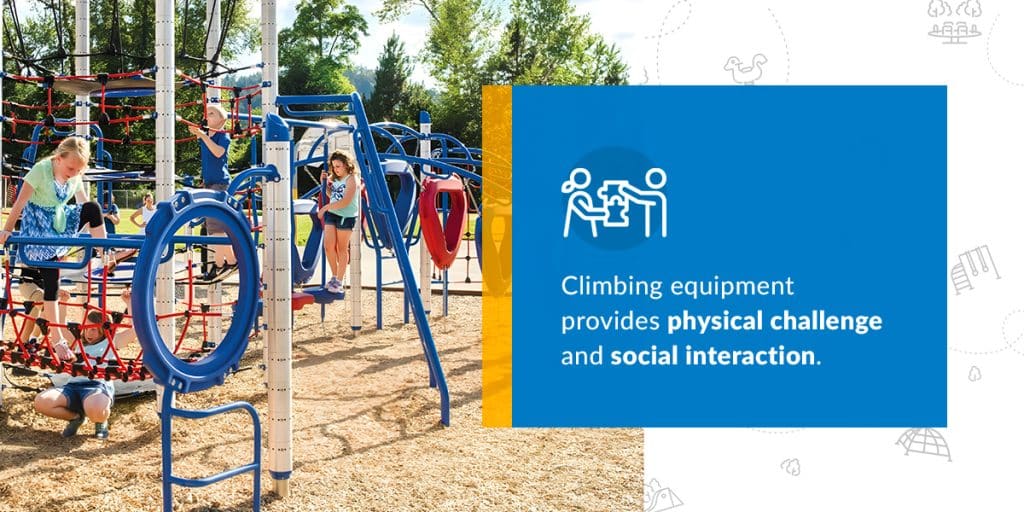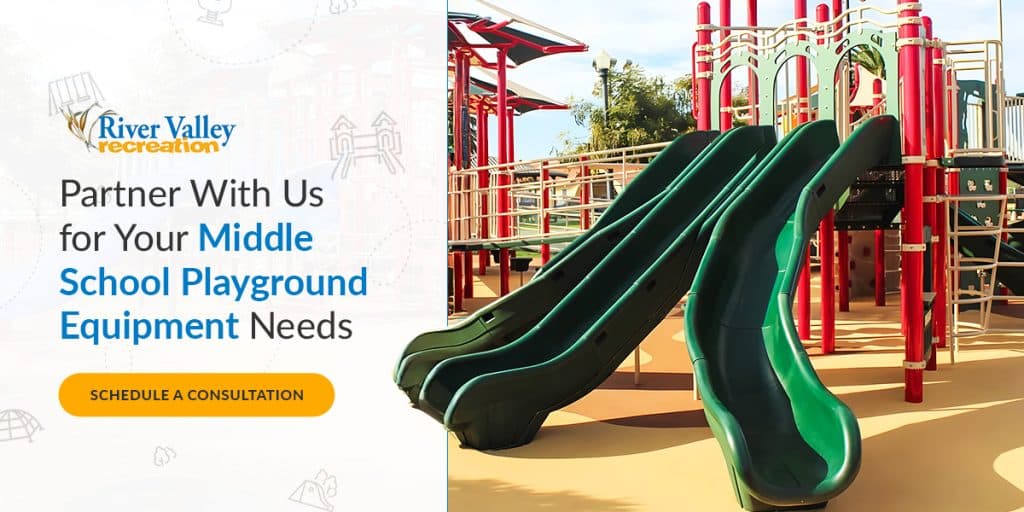Children between the ages of 6 and 17 need at least 60 minutes of physical activity daily, yet 80% are not meeting that goal. For middle schoolers balancing academics, technology and growing up, playgrounds provide a vital outlet.
The right playground equipment creates an environment that nurtures physical fitness, social development, creativity and emotional well-being. Learn why playgrounds matter for middle schools, how to choose the right equipment and tips to create an inclusive space.
Why Middle School Playgrounds Matter
Playgrounds in middle school help children balance independence and social interaction. Here’s why a well-designed playground is important.
Supports Physical Development
Middle schoolers experience changes in strength, coordination and endurance. Spaces that challenge their physical abilities through climbing, balancing and agility-based playground equipment give them the opportunity to strengthen muscles, build cardiovascular health and refine motor skills. Middle schoolers thrive on activities that push their limits just enough to feel rewarding.
Improves Emotional Well-Being
This age group is also exploring new stressors, from academic workloads to shifting peer dynamics. Play helps regulate mood. Time spent in open spaces and on active equipment stimulates endorphin release, supporting mental balance. Unstructured play gives students the chance to reset from structured school settings, helping them return to class with better focus.
Fosters Social Growth
Playgrounds foster collaboration and peer interaction. Climbing nets or obstacle courses encourage teamwork, negotiation and shared decision-making. These experiences foster cooperation and conflict resolution. The playground becomes a training ground for communication, empathy and leadership.
Enhances Cognitive Development and Creativity
Cognitive growth at this age leans on problem-solving, abstract thinking and creativity. Playgrounds stimulate these areas by challenging their strategy and experimentation skills. Creating games or improvising rules with peers also sparks creativity and flexible thinking.
Limitations for Middle School Playgrounds
Playgrounds face challenges if they don’t consider user needs and environmental context. The following issues impact their effectiveness:
- Inappropriate equipment: Selecting structures not designed for middle schoolers can lead to boredom, frustration or disengagement.
- Inclusive design limitations: Equipment that does not accommodate all abilities may leave some children feeling excluded.
- Injury risk: Inappropriate surfacing, lack of safety inspections and minimal adult supervision can lead to injuries.
- Maintenance issues: Without regular inspections and upkeep, playgrounds may deteriorate faster, reducing safety and play value.
Key Considerations for Choosing Middle School Playground Equipment
Selecting the right structures requires balancing developmental needs, safety, space and long-term costs. Explore how to choose middle school playground equipment.
1. Age Appropriateness
Playground equipment for middle schoolers should cater to their size, abilities and interests. At this stage, they are often too big for elementary school structures but not yet ready for adult fitness equipment. Features like climbing walls and rope courses provide challenges that keep them engaged while also supporting healthy risk-taking.
Compliance with established safety guidelines is important. Organizations such as the Consumer Product Safety Commission (CPSC) and the American Society for Testing and Materials (ASTM) International outline standards for fall zones, equipment spacing and design specifications. Adhering to these standards ensures the equipment challenges children while supporting their safety.
2. Space and Budget
Before purchasing equipment, decision-makers should assess:
- Available square footage and layout.
- Number of children expected to use the playground.
For smaller areas, vertical climbing towers or modular playground systems maximize play and footprint. Larger sites allow for diverse play areas, including fitness zones or obstacle courses.
Budget requires the same careful planning. Instead of stretching limited funds across too many pieces, prioritize versatile middle school playground equipment that serves multiple purposes. Additional features can be phased in later as funding becomes available.
3. Durability and Maintenance
Playground structures for middle schoolers must withstand greater weight, vigorous play and outdoor exposure. Powder-coated steel, heavy-duty plastics and UV-resistant finishes extend equipment life and reduce wear. Choosing weather-resistant hardware and corrosion-proof fasteners is vital in climates with heavy rain, snow or intense sun.
Upkeep should be part of the cost calculation. Regular equipment maintenance saves money in the long run by reducing the frequency of repairs or replacements. Organizations should also plan for routine inspections of moving parts to uphold safety.
4. Safety Surfacing
Safety surfacing cushions impact and helps prevent injuries since middle schoolers tend to climb higher and move faster than younger children.
Common surfacing options include:
- Poured-in-place rubber provides seamless coverage, consistent shock absorption and accessibility for children with mobility aids.
- Rubber mulch offers effective cushioning and is relatively low-maintenance.
- Engineered wood fiber (EWF) is cost-effective and has exceptional impact absorption.
Specific Equipment Recommendations for Middle Schoolers
Middle schoolers seek variety and activities that feel adventurous and stimulating. Consider the following when installing playgrounds for middle schoolers.
Climbing Structures

Climbing equipment provides physical challenge and social interaction. Options include:
- Rope climbers develop upper body and core strength. Their open design supports multiple users at once, promoting teamwork.
- Rock walls mimic real climbing experiences, offering a safe environment for children to test their grip strength, balance and problem-solving skills.
- Net climbers strengthen balance and coordination. Several children can climb simultaneously, so they double as social hubs.
Swinging Elements
Swings remain a playground classic, but for this age group, they need to provide variety. Consider:
- Belt swings offer a simple, familiar form of play. They build core strength and coordination.
- Tire swings allow multiple children to swing together, encouraging cooperation. They also introduce a rotating motion that adds excitement.
- Disc swings challenge balance and coordination. They feature a unique, less predictable swinging experience that keeps children engaged.
Sliding Elements
Slides evolve with age. For middle schoolers, consider complex options, such as:
- Curved slides add speed and unpredictability, keeping children interested beyond a simple straight descent.
- Tube slides provide enclosed pathways that add adventure and suspense.
- Roller slides reduce friction with moving rollers, creating a different sensory experience that feels fresh.
Balance and Coordination Equipment
Playgrounds for middle schoolers support athletic development and cognitive focus. Balancing equipment includes:
- Balance beams require concentration and physical control, skills that transfer to sports and daily activities.
- Wobble bridges simulate instability, pushing children to adjust quickly and improving reflexes.
- Stepping stones encourage imaginative pathways and games while refining agility and footwork.
Fitness and Challenge Courses
Fitness-focused playground zones cater to children who gravitate toward challenges that feel athletic. Incorporate equipment like:
- Obstacle courses combine climbing, crawling and balancing tasks into continuous play sequences, supporting endurance and teamwork.
- Agility courses focus on speed, coordination and quick thinking, ideal for children who enjoy athletic competition.
- Outdoor fitness equipment introduces age-appropriate strength and cardio elements, helping build confidence in physical activity.
Best Playground Amenities for Middle Schools
Playground amenities create a welcoming space for children and adults. Some features include:
- Shelters allow students and caregivers to use the playground year-round and create gathering spaces for social interaction.
- Park benches and tables give children a place to pause between activities and encourage peer conversation away from equipment.
- Buddy benches promote inclusivity by providing a space for students seeking a play partner.
- Bleachers are ideal for spaces where games or activities draw audiences. They support supervision and community participation.
- Trash cans keep the playground tidy and instill habits of environmental care.
The Importance of Inclusive Play
Inclusive play ensures that children with physical, sensory or cognitive differences have equal access to playground experiences.
Accessible playgrounds are beneficial because they:
- Create opportunities for children of all abilities to interact.
- Provide families with a shared community space.
- Support the holistic development of all children.
Features of Accessible Playgrounds for Middle Schoolers
Designing for inclusivity requires equipment that accommodates different abilities, such as:
- Ramps
- Accessible pathways
- Adaptive swings
- Sensory play panels
- Ground-level play features
Working With River Valley Recreation
River Valley Recreation offers various playground services to support schools and organizations. You get benefits like:
- Expert design and installation: Our team guides you from initial concepts to finished projects, ensuring equipment is age-appropriate and aligned with the site’s needs.
- Safety: All playgrounds meet CPSC and ASTM standards. Safety audits and inspections are available for compliance.
- Budget alignment: Our team works with you to identify solutions within your budget, offering cost-effective recommendations for features that deliver maximum play value.
- Support: River Valley Recreation provides maintenance and inspection services to extend the life of your equipment.
Partner With Us for Your Middle School Playground Equipment Needs
Designing and choosing middle school playground equipment requires planning and a partner who understands your goals. We can help you bring your vision to life by guiding you through initial design to long-term upkeep.
Fill out a form to schedule a consultation today!



